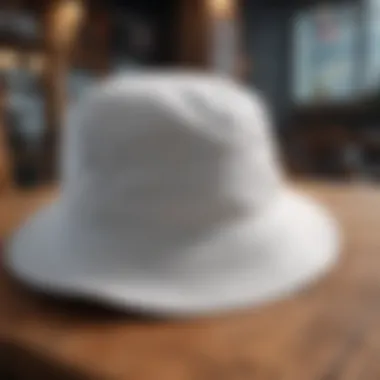The Plain White Bucket Hat: Where Function Meets Fashion


Intro
The plain white bucket hat stands as a unique accessory, a blend of functionality and style that transcends its humble beginnings. This uncomplicated headgear has cultivated a foothold in various realms, from outdoor sports to high-fashion scenes. Its features are designed not just for aesthetics but also for practical needs, making it a preferred choice among adventurers and fashion enthusiasts alike. In this article, we will examine its history, its place in sports and culture, as well as provide insights on material choices, design features, and maintenance tips pertinent to this enduring fashion staple.
The History of the Sport
Origin and Evolution
The bucket hat originated as a functional piece of headwear for fishermen and farmers. Its design allowed for sun protection and rain resistance. The simple, downward-sloping brim provides shade while the soft cotton fabric is light and breathable. Over time, it evolved from its utilitarian roots to become a symbol of leisure and style. From the 1960s onwards, it started gaining traction in pop culture, especially through its association with music and streetwear.
Milestones and Influences
The plain white bucket hat was prominently popularized by musicians and celebrities. In the 1990s, hip-hop culture contributed significantly to its rise. Artists often wore the hat in music videos and public appearances, merging it into everyday fashion. This exposure led to a wider acceptance beyond just sports and outdoor activities.
The bucket hat is not merely headwear; it’s a statement of identity across various cultures and lifestyles.
Key Athletes and Pioneers
In the realm of sports, several athletes have adopted the bucket hat due to its practicality. Tennis players and golfers, for example, have found it useful for shielding their faces from the sun. The iconic image of golfer Chi Chi Rodriguez in a bucket hat helped cement its place in sports culture. Additionally, extreme sports athletes, such as surfers and skateboarders, typically sport this hat, aligning with a lifestyle that values fun and adventure.
Material Choices and Design Features
Understanding materials in bucket hat production is crucial for choosing the right one. Common fabrics include cotton, polyester, and nylon. Each offers distinct advantages depending on the intended use – cotton is breathable, while nylon is lightweight and quick-drying. The design can vary, featuring adjustable straps, chin cords, and even ventilated panels, enhancing both fit and comfort. A plain white color adds versatility, making it suitable for various occasions.
Maintenance Tips
To keep a bucket hat looking its best, regular cleaning and proper storage are essential. Hand washing in cold water is recommended to prevent distortion. Avoid harsh detergents, and air dry the hat without direct sunlight to maintain its shape. When not in use, store the hat in a cool, dry place, preferably inside a drawer or on a shelf to prevent dust accumulation.
End
The plain white bucket hat encapsulates a unique blend of function and fashion. Its history and evolution tell a compelling story—one that reflects culture, practical utility, and individual expression. As it continues to adapt within the realms of sports and fashion, this accessory remains a testament to enduring style and versatility.
Preface to the Plain White Bucket Hat
The plain white bucket hat has transcended its utilitarian roots to become a cherished accessory in various domains. This section outlines the relevance of the bucket hat in today’s world, stressing its dual role in both functionality and fashion. Its simple design hides a multitude of benefits, catering to diverse needs ranging from sun protection to style statement.
Historical Context
The bucket hat emerged in the early 1900s, originally designed for use by fishermen. Made from durable cotton and featuring a wide brim that was meant to shield eyes from the sun, its practical origins laid the groundwork for its later cultural significance. By the 1960s, it found a place in military wear, further establishing its reputation for ruggedness and reliability.
As decades passed, the bucket hat maintained its popularity, finding favor in various subcultures. It appeared in the wardrobes of hippies, skaters, and joggers. Notably, the 1990s brought a resurgence of interest in the bucket hat, with brands like Ralph Lauren integrating it into their collections. This transition from utility to style has solidified the bucket hat's place in fashion history.
Cultural Significance
The cultural implications of the plain white bucket hat are notable. It serves as a canvas for personal expression and, at times, political statements. Many people wear it as a sign of affiliation with specific lifestyles or movements. The bucket hat has evolved into a symbol of casual coolness, bridging gaps between age groups and demographics.
Fashion designers frequently use the bucket hat to challenge norms. Its presence on runways has turned it into an emblem of avant-garde style. Furthermore, it appears in the wardrobes of celebrities, reinforcing its status as an icon within pop culture.
The evolution of the bucket hat reflects broader societal changes, showcasing its adaptability and enduring appeal.
Anatomy of the Bucket Hat
The plain white bucket hat, while seemingly simple in its design, is a fusion of practicality and aesthetic charm. Understanding the anatomy of this hat is essential for appreciating its versatility. Key elements such as material choices and design elements influence both functionality and style.
Material Considerations
The choice of material significantly affects the performance and comfort of the bucket hat. Most commonly, cotton is used for its breathability and softness. Lightweight polyester and nylon are also options, allowing for moisture-wicking properties. These materials help keep the wearer cool and dry, particularly during outdoor activities.


Using a durable fabric also adds to the longevity of the bucket hat. When participating in extreme sports, exposure to various weather conditions is common. Fabrics that resist fading and wear contribute to a longer lifespan of the accessory. Choosing the right material accommodates different needs.
Design Elements
The design elements of a bucket hat are central to its functionality and aesthetic appeal. They include brim width, crown height, and the construction of stitching and seams. Each element plays a role in defining the hat's character and practical uses.
Brim Width
Brim width is crucial for sun protection and style. A wider brim often offers better coverage from harmful UV rays, making it a favorable choice for outdoor enthusiasts. Many also find a generous brim visually appealing. However, it can restrict visibility during certain activities. A balance is needed to ensure both protection and ease of use. Generally, the brim ranges from 2.5 to 3 inches, which is considered a sweet spot for most users. This width provides substantial sun protection while maintaining comfort during wear.
Crown Height
Crown height influences how the hat sits on the head and its overall aesthetics. A higher crown provides a more relaxed look; some adventurers prefer this for airflow during sweaty activities. On the other hand, a shorter crown offers more structure and creates a more fitted appearance. A standard crown height typically measures around 4 to 6 inches, accommodating a variety of head sizes. It is important to note that a higher crown might lead to instability in windy conditions.
Stitching and Seams
Stitching and seams are often overlooked, yet they significantly affect durability and comfort. Strong, well-placed stitches ensure that the bucket hat withstands wear and tear, particularly in high-movement environments like sports. Double stitching is commonly preferred as it adds strength.
The type of seams used can also impact how the hat fits. Seamless designs, while more challenging to produce, can result in a more comfortable fit with fewer pressure points. The stitching should not interfere with the wearer's comfort during prolonged use. In harsh conditions, poor stitching can lead to unraveling, which diminishes the hat’s integrity.( https://en.wikipedia.org/wiki/Bucket_hat )
Understanding these elements provides deeper insight into the bucket hat's design and functionality. Each component works synergistically to offer both comfort and style, whether in fashion or outdoor activities.
The construction of a bucket hat must marry form and function for it to excel in diverse environments.
Practical Uses in Extreme Sports
The plain white bucket hat is not just a fashion statement; it serves as a vital tool for those engaging in extreme sports. This accessory brings a blend of functionality and style that cannot be overlooked. The hat is designed to cater to the unique needs of adventure seekers, enhancing their performance while providing essential protection.
Sun Protection
Extreme sports often take place in open environments where exposure to sunlight is significant. The plain white bucket hat, with its broad brim, offers direct sun protection. This feature can significantly reduce the risk of sunburn and heat-related health issues.
When engaging in activities like surfing, rock climbing, or mountain biking, prolonged sun exposure without protection can lead to skin damage. Wearing this hat minimizes these risks. Additionally, the light color reflects sunlight, keeping the head cooler than darker options.
Some specifics to consider include:
- Brim Size: A wider brim enhances sun shield effectiveness.
- Material: Breathable fabrics allow for sweat evaporation, ensuring comfort.
- Fit: The hat should fit snugly to avoid it flying off during high-speed activities.
“Sun protection is critical in extreme sports. The bucket hat's design addresses this concern effectively.”
Ventilation and Comfort
Comfort plays a crucial role in extreme sports, where physical exertion can lead to overheating. The plain white bucket hat is often designed with ventilation features that promote airflow. This is essential when athletes are moving vigorously for extended periods.
The primary aspects that contribute to this comfort include:
- Mesh Panels: Many bucket hats incorporate mesh for added airflow, helping to regulate temperature.
- Moisture-Wicking Technology: Fabrics that wick away sweat help keep the wearer dry and comfortable.
- Adjustable Straps: These allow for a customized fit, reducing the risk of discomfort or distraction during activity.
Bucket Hat in Fashion
The bucket hat has transitioned from a practical outdoor accessory to a significant component in the fashion world. Its unique silhouette and functionality appeal to various audiences. The plain white bucket hat especially serves as a canvas for personal expression in its simplicity. This section delves into the roles it plays in streetwear and on notable runways, shedding light on how this accessory blends into fashion trends and serves as a symbol of cultural relevance.
Streetwear Influence
Streetwear has emerged as a dominant force in global fashion, showcasing the bucket hat as a staple accessory. Its versatility allows it to pair well with oversized tees, baggy jeans, and sporty sneakers. The plain white color makes it adaptable, contributing to a minimalist aesthetic that defines much of contemporary street fashion.
Notably, brands like Off-White and Supreme have integrated bucket hats into their collections. The appeal lies in their ability to convey casual coolness while providing sun protection, particularly during summer months. Studies show that streetwear enthusiasts often seek out items that transcend basic functionality and become symbols of social status. When worn, the bucket hat can signal affiliation with urban culture.
Here are some points on streetwear's use of bucket hats:


- Brand Collaborations: Collaborations with well-known athletes and influencers have pushed the bucket hat into mainstream traffic.
- Personalization: Many wearers customize their hats with patches or embroidery, enhancing their individuality.
- Fashion Cycles: The cyclical nature of fashion means that trends often come back; the bucket hat is a prime example of this.
Runway Trends
Runway shows often set the tone for forthcoming fashion seasons, and the bucket hat frequently makes appearances in collections from various designers. Major fashion houses have adopted the plain white bucket hat, showcasing its stylish adaptability in both haute couture and more casual lines.
High-profile designers illustrate that the bucket hat can embody elegance and sophistication. For instance, collections from designers like Chanel have turned the bucket hat into a fashion statement, further confirming its place on the runway. The marriage of practicality and style is evident when it is showcased alongside tailored suits or elegant dresses, blurring the lines between casual and formal wear.
Key observations regarding runway trends include:
- Statement Pieces: Designers use the bucket hat as a statement accessory, often integrating bold textures and fabrics to elevate its status.
- Cultural References: Many collections draw on nostalgia or cultural references, which enhances the hat's appeal.
- Versatility in Styling: Fashion influencers frequently showcase how the bucket hat can transition from the runway to daily wear effortlessly.
The plain white bucket hat not only serves an aesthetic purpose but embodies a broader cultural movement. Its usage in both casual and high-fashion contexts demonstrates its versatility.
By examining the influences of both streetwear and runway trends, we can gain insight into the cultural significance of the bucket hat today. It has evolved from mere practicality to an icon, reflecting social identity and style preferences among diverse groups.
Popular Variations of the Bucket Hat
The bucket hat has evolved significantly, shedding its utilitarian roots to become a style statement. This section explores the popular variations of the bucket hat and their significance. These variations reflect not only personal style but also seasonal trends and the diverse contexts in which the hat is worn.
Patterned vs.
Plain
When choosing between patterned and plain bucket hats, one must consider the context and individual taste. Plain white bucket hats are often favored for their versatility and ability to match any outfit. However, patterned options can provide a bold statement and showcase personality. Patterns can vary greatly, from floral prints to abstract designs. Each offers an opportunity for self-expression.
Benefits of Patterned Bucket Hats:
- Visual Interest: Patterns can add flair to an outfit, making a simple ensemble look more dynamic.
- Cultural Significance: Some patterns may be linked to specific cultures, offering a way to celebrate heritage.
- Uniqueness: Wearing a patterned hat can help individuals stand out in a crowd.
On the other hand, plain hats serve a different purpose:
- Simplicity: They can be paired with virtually any clothing, maintaining a clean look.
- Timelessness: A plain white bucket hat remains in fashion regardless of changing trends.
- Adaptability: Easily dressed up or down, suitable for various occasions.
Seasonal Designs
Seasonal designs of bucket hats highlight their adaptability throughout the year. As the weather changes, so do the materials and styles of bucket hats. Lightweight cotton or linen is ideal for summer, while heavier fabrics may be used in colder months. These variations allow for comfort and practicality based on environmental conditions.
In summer, bright colors or tropical themes are more common. Designs may reflect beach scenes or vibrant florals, resonating with outdoor activities and vacations. Conversely, autumn and winter designs may utilize darker shades and textured materials like wool, suiting the coziness often sought during these seasons.
Considerations for Seasonal Bucket Hats:
- Material Suitability: Select fabrics that provide adequate warmth or breathability depending on the season.
- Color Palette: Align hat color with seasonal trends to stay stylish.
- Functional Features: Some seasonal hats may include features like wind resistance or water repellency for added practicality.
Ultimately, the evolution of bucket hat designs, whether patterned or seasonal, continues to enhance this accessory's appeal. Choosing the right variation can significantly elevate one’s look and function effectively across varying circumstances.
Maintenance and Care
Maintenance and care of the plain white bucket hat is crucial to ensure its longevity and aesthetic appeal. As an item that bridges functionality with style, it is often exposed to various elements, including sun, rain, and sweat. Proper care helps maintain its shape and fabric integrity, which enhances its overall performance in different environments, particularly for adventure seekers and extreme sports enthusiasts.
Cleaning Techniques
Cleaning the bucket hat requires a delicate balance. It is essential to remove dirt, sweat, or any stains promptly to avoid permanent marks. Here are some recommended techniques:
- Hand Washing: Use mild detergent and cold water. Soak the hat for a few minutes, then gently scrub with a soft cloth or sponge.
- Avoid Bleach: The bright white color can be ruined by bleach or harsh chemicals. Stick to gentle soaps instead.
- Spot Cleaning: For minor stains, dab the area with a damp cloth and a bit of detergent, rinsing afterward with cold water.
- Drying: Always reshape the hat after washing and place it on a flat surface to dry. Do not use a dryer; high heat can warp the fabric.
Storage Recommendations


Storing your bucket hat properly can prevent unwanted damage and maintain its stylish appearance. Consider these practices:
- Cool, Dry Place: Keep the hat away from direct sunlight and humidity. This helps prevent fading and fabric deterioration.
- Avoid Crushing: Store the hat in a way that it retains its shape. You can use a hat box or even a clean, dry towel as padding.
- Rotate Usage: If you own multiple bucket hats, alternate between them to minimize wear and tear on a single piece.
Maintaining your plain white bucket hat through these cleaning techniques and storage recommendations will not only extend its life but also preserve its function and style. This approach reflects a commitment to look sharp while pursuing outdoor adventures or simply enjoying a day in the sun.
Case Studies: Iconic Moments
The plain white bucket hat has a unique place in cultural history, gaining recognition through various iconic moments. This section examines how these moments cement the bucket hat not just as a functional accessory but also as a statement piece.
Celebrity Endorsements
Throughout the years, numerous celebrities have donned the plain white bucket hat, significantly elevating its status in fashion. Prominent figures like Pharrell Williams and Rihanna have been seen wearing this accessory at high-profile events. Their endorsement has led to widespread acceptance and popularity of the hat. Celebrity choices often influence trends, and when it comes to the bucket hat, these personalities have done it well.
Wearing a plain white bucket hat can be perceived as a bold yet casual choice, blending effortlessly into various styles, from streetwear to formal wear. The association with celebrities has given it a feel of exclusivity and trendiness. Many individuals may aspire to replicate the looks seen on these icons, thus enabling the hat itself to traverse from functional to fashionable seamlessly.
Influence in Music and Art
The influence of the plain white bucket hat does not stop at fashion; it continues into music and the broader realm of art. Various musicians have incorporated the bucket hat into their performance wardrobes, making it a staple on stage. Artists like the late Tupac Shakur and contemporary musicians like Tyler, The Creator have utilized bucket hats to enhance their distinguished styles. In music videos and performances, the bucket hat becomes more than an accessory; it’s a symbol of belonging to a particular cultural movement.
Furthermore, within visual arts, the bucket hat has made notable appearances in various artworks. Featuring this hat in paintings and installations speaks to its symbolic representation of youth, rebellion, and authenticity. Artists often use it as a visual cue to convey deeper messages about culture and identity. Its broad applicability in music and art showcases its evolving significance.
The plain white bucket hat stands as a testament to how functionality and style can coexist, transcending both the realm of sports and the world of societal trends.
Psychology of Wearing a Bucket Hat
The psychology behind wearing a bucket hat goes beyond mere aesthetics. This accessory serves as a reflection of personal identity, individual expression, and even social group dynamics. Understanding why people choose to don this particularly recognizable headwear can provide insights into broader cultural contexts and self-perception.
Identity and Expression
Wearing a bucket hat allows individuals to communicate aspects of their personality. It can be a bold statement or a subtle choice, depending on the specific style and accompanying attire. The simplicity of the plain white design adds versatility, making it a blank canvas for personal expression. People often pair it with casual outfits or sportswear, reinforcing ideas of comfort and practicality.
The bucket hat has found its place in various subcultures, allowing its wearers to signal affiliations, whether that is with skateboarding, hip-hop, or outdoor activities. Each group has its own nuanced interpretation of the hat, influencing choices in materials, patterns, and accompanying fashion. In this way, the bucket hat becomes a medium through which individuals express their identity, join conversations about lifestyle, and align with various communities.
Cultural Identity
The cultural significance of the bucket hat cannot be overlooked. Initially, this headwear was designed as functional attire for outdoor activities, but it has evolved into a potent symbol within different cultures. From its African origin, where it served practical purposes under the sun, to its adoption by Western fashion, the bucket hat carries layered meanings.
Cultural identity is often expressed through fashion choices, and the bucket hat is no exception. Different communities appropriate the style to resonate with their cultural narratives. For instance, in the music scene, it has become synonymous with various genres, from reggae to hip-hop. Its presence in streetwear adds another dimension, enabling the seamless blend of function and style.
Additionally, global fashion influencers have played a significant role in popularizing the bucket hat. As these cultural icons wear it, the hat transcends its original purpose, becoming emblematic of a lifestyle that embraces both heritage and modernity.
The bucket hat stands as a cultural artifact, allowing wearers to navigate their identities, beliefs, and styles while remaining functional and stylish.
The Future of Bucket Hats
The bucket hat, especially in its plain white variant, has solidified its place within the realms of fashion and functionality. However, as trends evolve, it is critical to assess what the future holds for this quintessential accessory. There are two considerable pillars worth focusing on: innovative designs and sustainability efforts. These aspects not only define the next phase in bucket hat evolution but also reflect broader social and environmental trends.
Innovative Designs
In recent years, creativity has become a driving force within the fashion industry. Bucket hats are no exception to this transformation. Designers are beginning to experiment with materials, functionality, and aesthetics to cater to evolving consumer preferences.
One notable trend is the rise of tech-infused bucket hats. Advances in materials science may lead to the development of hats that provide enhanced UV protection, moisture-wicking abilities, or even embedded cooling technology. Fashion-forward individuals might see designs that incorporate reflective materials, enhancing visibility during outdoor activities.
Moreover, personalization is becoming more popular. Consumers are seeking hats adorned with unique embellishments, custom prints, or even digital elements. These options allow for a deeper sense of identity expression through simple headwear. The blending of artistry and practicality continues to shape the direction of bucket hat fashion.
Sustainability Efforts
With the global emphasis on environmental consciousness, sustainability stands out as a critical discourse in the future of the bucket hat. More brands are exploring eco-friendly materials and production processes that reduce waste and promote circular fashion.
Some manufacturers are turning to organic cotton or recycled polyester as sustainable fabric choices. These materials not only lessen environmental impact but also appeal to eco-conscious consumers who prioritize responsible purchasing. A focus on natural dyes can further enhance the sustainability factor.
Consumers are increasingly seeking brands that embrace transparency in their manufacturing processes as well. This demand encourages companies to adopt fair labor practices and environmentally friendly methods. Investing in sustainability not only positively impacts the planet but also elevates brand reputation and consumer loyalty.
As the bucket hat continues to evolve, the intersection of innovative designs and sustainability will play a significant role in its future.







